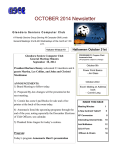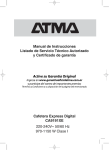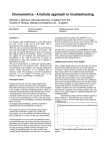Download Oct - Delaware Photographic Society
Transcript
The Reflector Delaware Photographic Society O c t o ber 2 0 0 9 www.delawarephotographicsociety.org Volume 62, Issue 2 Bob Krist Presents October Program Photo: Bob Coffey W Bob Krist October 26 ▪ 7:30pm Cokesbury auditorium, Level C Real Life Problems in Travel Photography and How to Solve Them e are extremely pleased to welcome award-winning photographer Bob Krist as our October guest speaker. Bob has worked for National Geographic, Smithsonian, and Outdoor Photography magazines, to name a few. His many awards include Travel Photographer of the Year. Bob is based in New Hope, Pa and we are most fortunate to catch him between assignments. Visit www.bobkrist.com for a view of Bob’s awesome photographs, workshop schedules, prints, videos, books, and stock portfolio. Join us at 6pm for dinner with the speaker in a private Cokesbury dining room. Reservations must be made in advance to John Hamilton at [email protected] / 302.479.0222. Dinner cost is $17.25, all inclusive. Sorry, no walk-ins. My Thoughts By Karl Leck, President T he Society’s year is off to a flying start with an unprecedented number of entries by newer members in the monthly competitions. That’s great! We welcome our members’ enthusiasm in wanting to show their images. I saw several truly memorable images. Another topic that is off to a flying start is some frustration with the competition scoring. That’s something I expect nearly every month. Our competitions are subjective. They depend on the judge’s ability to quickly evaluate the image, and then be prepared to discuss the image. It’s not an easy continued on page 2) Calendar of Events Through Nov. 1 Annual Pot Luck Supper — October 5 T his year, the ever-popular Pot Luck Supper will be held on Monday, October 5, at 6:30pm in the duPont Pavilion. The evening’s program, Flickr—Sharing Your Photos on the Internet, will be presented by Sandro Cuccia. Flickr, www.flickr.com is touted as the best Web site for online management and sharing applications in the world, and Sandro will describe how we can easily maximize the use of this free resource. What to bring: Couples bring main dishes; singles contribute salads, vegetables, breads or desserts. Plan for 8 servings per dish and please bring serving utensils. We have no way of heating food so dishes will be served at room temperature. Soda, wine, coffee, and tea will be provided. Volunteers are needed for set up and clean up. Please RSVP to Carole at [email protected]/ 610.358.5191 by October 1. DPS/Longwood Gardens Exhibit Oct. 5 Entry Deadline Projected Image Competition Oct. 5 6:30pm — Pot Luck Supper Program “Flickr” Sandro Cuccia Oct. 12 7:30pm — Projected Image Competition Oct. 19 7:30pm — Print Competition Oct. 26 6pm — Dinner with Speaker 7:30pm — Bob Krist Cokesbury Auditorium, Level C The Reflector DELAWARE PHOTOGRAPHIC SOCIETY October 2009 My Thoughts 2009-2010 (Continued from page 1) President — Karl Leck 610.388.0298 / [email protected] Vice President — Jeff Smith 302.368.1089 / [email protected] Recording Secretary — Dee Langevin 302.376.7645 / [email protected] Treasurer/Corp. Secretary John Blankenbaker — 610.388.1305 [email protected] Exhibition Chair Dianne Carnegie — 410.398.2397 [email protected] Education Director — Bob Coffey 610.388.2741 / [email protected] Projected Image Director Pete Lounsbury —302.636.0868 [email protected] Print Director — John Haedo 484.480.4430 / [email protected] Program Director — John Hamilton 302.479.0222 / [email protected] Reflector Editor — Sharon Coffey 610.388.2741 / [email protected] Membership — Ruthann King 302.299.2665 / [email protected] Field Trips — Steven Sieja 302.540.9283 /[email protected] Awards Committee — Jane Strobach 302.994.8167/ [email protected] Equipment Chair — Bud Easler 610.444.2581 / [email protected] Publicity Chair —Open Judges Chair — Tom Tauber 610.626.1579 / [email protected] Standards Chair — John Hamilton 302.479.0222 / [email protected] DPS Webmaster — John Davis webmaster@ delawarephotographicsociety.org The Delaware Camera Club (DCC) was established January 28,1931. DCC is a charter member of the Photographic Society of America and The Delaware Valley Council of Camera Clubs. In 2002 the name was changed to the Delaware Photographic Society (DPS) and the Society became a tax deductible educational organization. task. I judge 5-10 competitions at other venues during the year, sometimes as the sole judge, and other times the exhibitors want comments on each image. A lot depends on the judges’ breadth of photographic experience and ability to calmly present their thoughts. Tom Tauber has tried to bring new eyes to our competitions and enlarge the portfolio of qualified judges. Some of these new judges do well, but some are not able to quickly evaluate the image or elucidate their thoughts. They will not be ask to judge again. The best judges will be given the opportunity to judge each year and possibly judge our international exhibition. The September print competition showed that some members are having difficulty making quality prints. Our organization has always prided itself in producing prints of the highest artistic and technical quality. In order to technically succeed in our competitions, a print must have color accuracy, dynamic range without needless blown highlights or muddy shadows, and clean mounting. From time to time the Society has given classes on these topics. We will continue to do so, but I started thinking about a faster way. Having one of our master printers work with one to five members, preferably at the student’s computer/printer, can convey the specific knowledge needed to improve their print quality. I’m happy to help anyone who asks. I can also introduce new members to some of our best printers for help. There is no magic bullet in getting a beautiful print, just a lot of items that require attention. Some of these are monitor calibration, printing 2 resolution, dynamic range (Check the histogram!), paper/ink compatibility, and the ICC profile for the printer/ink/paper used. Confused? Talk to me about your situation. There are excellent books on digital printing. Jon Canfield and Tim Grey wrote Photo Finish, and Tim Grey authored Color Confidence (both published by Sybex 2004). Lark Books published the Epson Complete Guide to Digital Printing by Rob Sheppard. If you try the book route, you may have questions or need clarification. Ask me or Education Director, Bob Coffey. We will be glad to help. Are you signed up to use our Yahoo! Group DPS-Exchange? If not, check it out at [email protected] and follow the directions. The DPSExchange is a great place to ask photographic questions and get answers based on actual experience by our members. There’s a lot going on this year. Let’s all enjoy capturing images and sharing and learning together. Z We hate to lose you!!! If you have not renewed your DPS membership, this is the last issue of The Reflector that you will receive. You may renew online, at a meeting, or by mailing a check for $35 for single or $60 for couple (payable to DPS) to John Blankenbaker, P.O. Box 120, Chadds Ford, PA 19317. Dues must be paid in order to participate in DPS exhibits, competitions, and receive important DPS notices. Contact John at [email protected] or 610.388.1305 with questions. The Reflector October 2009 Instruction Night Lineup I nstruction Night classes are held in the duPont Pavilion at 7:30pm, on the first Monday night of the month. For additional information, contact Education Director, Bob Coffey at [email protected] or 610.388.2741. ▪ November 2: Print Critique, Jay Greene. The best instruction in print competition comes from the judges’ comments during the contest. Historically, print makers have had more commentary due to their smaller size resulting in more time for instructive discussion. As a frequent DPS judge for many years, Jay has developed a well-deserved reputation for his outstanding critique by concentrating on the positive aspect of how a print could have been made better. Bring one of your problem prints for him to review and learn how you could improve it. ▪ December 7: Composition, Joe Rossbach ▪ January 4: Preparing Images for Slide Shows, Competition, E-Mail and Website, Bob Coffey ▪ January 31: All-day workshop on Getting the Most Out of Your Printer; Gary Stanley; Maine; fee ▪ February 1: Printing, Gary Stanley March 1: ProShow Gold Slide Show Preparation; John Toutkaldjian and Pete Lounsbury ▪ April 5: HDR (High Dynamic Range) Photography, Dick Greenwood ▪ May 3: Flash Photography (with emphasis on wireless), Bob Coffey Free Photography Classes ▪ Beginner’s Elements Classes John Haedo teaches a free Photoshop Elements class on Tuesdays at 7pm in Rm 301-B, Edgemoor Comm. Center, 500 Duncan Road, Wilmington. For more information, you may contact John at 484.480.4430 or [email protected]. ▪ Newark Classes Photoshop Elements classes will resume in Newark on October 7, at 7pm. Pete Lounsbury will teach the class on the first Wednesday of each month in Rm. 2 at the Newark Senior Center, 200 White Chapel Drive, Newark, DE 19713. For more information, contact Pete at 302.636.0868 or [email protected]. Vignettes • is held the first Monday of the month at 7:30pm. • This hands-on class is suited for those new to photography or digital equipment. The comprehensive sessions will cover: getting beyond "point and shoot", learning the creative modes, making adjustments for better photos, learning how to get the pictures off the camera, learning how to format your flash card, and learning how to get more pictures on a card. Bring your camera, manual, and questions. For more information, contact Bob Hunt at [email protected]. The sessions will run through December 17. 3 Competition nights are held on the second and third Mondays at 7:30 pm. • Program night is the last Monday of the month at 7:30 pm. • Location: Cokesbury Village, duPont Pavilion, 726 Loveville Road, Hockessin, DE 19707. Guest speaker programs are presented in the Cokesbury auditorium. • Membership dues should be addressed to: DPS Treasurer, John Blankenbaker, P.O. Box 120, Chadds Ford, PA 19317. Dues are $35 for individuals, $25 for others at the same address, and half the individual for junior or nonresident members. Dues for first–year members are $20 per person. • ▪ Bob Hunt is teaching a basic class on “Getting the Most From Your Digital Camera” on Thursdays at Edgemoor Community Center, 500 Duncan Rd., Wilmington, DE 19809 from 7 to 8:30 pm. Instruction Night The Reflector is published by the Delaware Photographic Society, and printed by Academy Printing. No material may be reproduced without written permission. Contribution deadline is the third Monday of the month. Send announcements or articles to Sharon Coffey at 48 Partridge Lane, Kennett Square, PA 19348 or [email protected]. • DPS members are encouraged to participate in our Yahoo group, DPSExchange. For information, go to [email protected] • Visit our Web site at: www.delawarephotographicsociety.org This program is made possible, in part, by grants from the Delaware Division of the Arts, a state agency dedicated to nurturing and supporting the arts in Delaware, in partnership with the National Endowment for the Arts. The Reflector October 2009 Questions & Answers Contributed monthly by Erik Kissa For more information on photographic equipment and techniques visit me at www.psa-newmember.org, open Consultation Services, and click on Exploring Equipment and its Use. Do you save all the layers and Q :selections of the image you image in Photoshop or in Elements usually follows a routine workflow. Saving each step makes sense only if the same editing sequence is applied to other images, like in batch processing of several selected images or a folder. The process of creating an artistic derivative of the original image involves much experimentation, many editorial steps, deleting some, and selecting a new path. The picture shown below is one of the images that requires so many complex editorial steps that saving of the intermediate files is not practical. have edited in Photoshop? A : Saving all layers and selections has the advantage that a modification of the image can be made without having to start from the beginning, and the same path can be applied to several images. However, saving the intermediate data requires much disk space and complicates file management with data that may not be used. The obvious disadvantage of not saving all layers and selections is the impossibility to use the same editorial sequence for another image. However, this is usually not a practical problem: photographers who like to control the processing of an image shoot in RAW (NEF) mode. It is very important to save all useful RAW files. When an image is converted and edited in Camera RAW or in Lightroom, the computer automatically saves the XMP data. Therefore, the preliminary editing does not have to be repeated when the same RAW image is opened again. Subsequent editing of the and my camera do Q :notMyhavelensstabilization. A tripod is too cumbersome for me. What are the other options for getting sharp pictures? A : Several options are available for making sharp pictures. A monopod is as affective as the optical stabilization. I use mainly the Monostat RS16K ART, maximum length 60", closed 20.5", weight 1.4 lb. This Swiss made monopod is not cheap ($175 + shipping). A quick release system, preferably with a ball head, is a must accessory for every monopod. A light weight stabilizer is a chain with a tripod screw at one end. 4 Stepping on the chain and pulling the camera up minimizes camera movement. This simple device was once an accessory for the Leica camera. Some P/S cameras use Auto ISO to stabilize the camera. The camera increases the ISO setting, if needed, to maintain a sufficient shutter speed for sharp pictures. This mode of ISO control works with modern DSLR cameras as well, because the picture quality does not suffer significantly when the ISO value is increased to 800. This is how the Auto ISO works. Take test pictures at different shutter speeds to indicate the minimum shutter speed needed for sharp pictures. As an example, the minimum shutter speed for an 18-50mm short zoom may be 1/50s. Select the S mode (Tv for Canon) and program the Auto ISO for a minimum shutter speed of 1/50s and the maximum ISO value of 800. This setting is equivalent to a two-stop shutter speed reduction with an IS or VR stabilizer. The shutter speed 1/50s at ISO 800 is equivalent to 1/12s at ISO 200. The shutter speed can be increased if needed to stop action, but the minimum speed in this example is 1/50s. You may find that you need at least 1/125s for a long zoom. Again, switching automatically from ISO 200 to ISO 800 is like having an optical stabilizer with the two-stop effectiveness at ISO 200. If the Auto ISO program is not used, the shutter-preferred exposure control will maintain the minimum shutter speed by increasing the aperture, if needed. This results in a reduced depth-of-field which may be desirable or undesirable, depending on the purpose of the The Reflector October 2009 Questions & Answers (Continued from page 4) picture taken. A technique that works sometimes is to minimize camera movement by shooting a burst. Usually, the first picture shows the effect of camera movement when the shutter release was squeezed, but at least one of the following Images may be sharp. Although optical stabilization is very desirable, the dependence on optical stabilization can lead to unsharp images. Optical stabilization does not eliminate unsharpness caused by a movement of the subject. What is the difference beQ :tween SD and SDHC memory cards? : The SDHC is a high capacity SD card. The standard SD memory cards have a maximum capacity of up to eight gigabytes. The SDHC cards can hold up to 32 GB. The new SDXC cards can store even more data, perhaps up to one TB. Both the SD and the SDHC card are designated as the Class 2, 4, or 6, according to the writing speed. A 133x or 20 to 33 MBs writing speed of a Class 6 card is useful only for some new DSLR cameras and fast card readers. The older cameras do not benefit from the high writing speed of the card. In other words, buying a high speed memory card may be a waste of money. The camera user’s manual lists the supported memory cards. The new SDXC cards will have a read/write speed of 300 MBs, not supported by the DSLR cameras today. A standard SD card and an SDHC card have the same physical dimensions, but the interface is different. Therefore, the SDHC cards cannot be used in older digital cameras. A The SD cards are small and used mainly in point-and-shoot cameras and in DSLR cameras designed for amateurs. Perhaps the reasoning is that most buyers of lower-end DSLR cameras are upgrading their P/S equipment and using a SD card already. Professional photographers do not like the SD cards because they are small and they prefer the larger CF compact flash card. It is somewhat surprising that the Nikon D300s, the flagship of the Nikon line of cameras with FD sensors, has two slots. One slot is for a CF card and the other for a SD card. Some doomsayers predict that the CF card will eventually disappear and be replaced by the SD card, but this is unlikely. The CF card is believed to be more sturdy and dependable. Erik Kissa Send questions to [email protected] 2009—2010 Assigned Subjects Assigned subject entries MUST have been taken within one year of entry. There is no time limit in the Open category. October — Visual Reflection* November — At Night January — Fun February — Ruins OR Dilapidation March — Converging Lines April — Light and Dark * Pete Lounsbury offers the fol- lowing explanation: Visual means you can actually see it. This would include mirror reflections, water reflections, reflections from any reflective surface as opposed to being reflective in thought. That's why the topic is "visual" reflections and not just reflections. We want to see the light, not the emotion. For equipment purchases, Cameras Etc. in Wilmington and Newark, are top notch. Owner Jim Cycyk is heartily endorsed for knowledge and helpful service. Please identify yourself as a DPS member when shopping in a Cameras Etc. store. 5 The Reflector Real Noser by Helen Gerstein Helen and Marvin tied for the top score in the September projected image competition October 2009 Cactus by Dianne Carnegie Cactus received a perfect score in the September print competition Old Salt by Marvin Gerstein Another Honor for DPS ! D PS has won the PSA Interclub Creative Competition for 2009. Twenty-nine photography clubs participated in this event and submitted selected members’ photos in three rounds of competition from January through September of this year. Entries were limited to “altered reality” photographs. DPS finished seven points ahead of the second place club, the Stony Brook Camera Club, and nine points ahead of the third place finisher, the Pixel Image Camera Club. DPS took the lead in the first round, and held that lead throughout all three rounds. Twenty-seven of our members submitted photos for this competition, and each club was permitted to submit six photos for each round. Over the course of the three rounds, four Delaware Photographic Society members distinguished themselves individually. In the first round, Karl Leck earned a second place with his photograph Woman Anew, Emily Reed won third place with Bad Catnip and Jane Strobach received an honorable mention for her photo Canned Entertainment. In the third round, Bob Coffey earned an honorable mention for his photograph entitled Photomontage. A big thank you to all of the members who submitted their fine creative photographs to make this win possible. Marvin Gerstein PSA Creative Competition Coordinator Erik Kissa to Serve as PSA Representative E rik Kissa is our new PSA representative. He will keep DPS members informed of PSA activities, describe the advantages of being a PSA member, facilitate applications for PSA membership, help us to enter PSA recognized exhibitions, and communicate to PSA the concerns and suggestions of PSA members. Erik is a long-time PSA member and an active exhibitor. He has accumulated over 2600 acceptances of projected images and prints in international photographic exhibitions and earned the distinction of excellence in photography (EPSA). His photographs have been exhibited on every continent of the world, with the exception of the polar regions. Erik would like every DPS member to become a global exhibitor. 6 PSA has a lot to offer. You may visit the new member website at www.psa-newmember.org and find mentors who are available to teach almost every aspect of photography to PSA members. Information on equipment and its use is available to all DPS members because the consultant is a DPS member. Erik Kissa may be reached at [email protected]. The Reflector Field Trip October 2009 Longwood Exhibit F ield trips are an excellent way for members to absorb information from more experienced member photographers and to share the camaraderie of an interesting outing. Karl Leck has suggested a field trip for Saturday, October 10 to Rough and Tumble, Time of Harvest in the near-by Pennsylvania Dutch country. This popular fall festival offers photo ops galore — from steam engines, a working sawmill, a blacksmith shop, a rope maker, to games such as barrel train ride, and pumpkin bowling. If you would like to carpool, we will meet in the Longwood Gardens parking lot at 9am. If you want to go on your own, Rough and Tumble is located on Rte. 30, Lincoln Hwy. E, Kinzers, PA 17535; Web site: www.roughandtumble.org. Toast to Vineyards by Rob Tuttle On display at Longwood Gardens F ruits of Pollination, a juried DPS exhibit, will be on display in the Longwood Gardens Visitor Center through November 1. The exhibit is located to the right of the front entrance and along the corridor from the bus entrance. An admission fee is not required to view photographs in the Visitor Center. Garden hours are from 9am—5pm daily, September 6—November 22. For information on Longwood Gardens events, refer to their Web site at www.longwoodgardens.org Longwood has invited DPS to exhibit our photographs again next year. Making Scents — The Art and Science of Perfume will be the featured Longwood theme for 2010, concentrating on fragrant plants and how we find emotional attachment to some. Start preparing your images and watch for more information in future newsletters. Photo Ops ▪ October 10: 18thCentruy Market Faire and Tavern Night. Greenbank Mills and Phillips Farm will host an encampment of re-enactors and a recreated 18th-century market and artisan faire. Experience 1781 Delaware and discover the world of Revolutionary soldiers and sailors. Enlist in the militia; and try military life for yourself, stroll through the market and investigate the items that were available to the 18thcentrury Delawarean; and help the artisans produce items for market. You may also photograph hearth cooking or explore the world of food during the Revolution and learn how to grow wheat, grind it into flour, and bake it into bread for home and army. In the evening, enjoy 18th-century games, food and drink in the Greenbank Tavern. Greenbank Mills is located at 500 Greenbank Road, Wilmington, DE 19808. Adults $7, Children 3-12 $5, Seniors $5. For additional information, contact www.greenbankmill.org or 302.999.9001. ▪ FOLIAGE WATCH New England: www.gonewengland.about.com NH: www.visitnh.gov VT: www.vtliving.com/foliage MA: www.mass-vacation.com WV: www.wvforestry.com NC: www.visitnc.com (leaf color) VA: 1-800-434-LEAF MD: 1-800-LEAVES-1 7 . The Photographic Society of America (PSA) is the largest organization of its kind in the world, bringing together amateur and professionals in all the varied fields of photography, including color slides, nature, pictorial prints, stereo (3D), electronic photography, video/motion pictures, photojournalism, travel photography, and devotees of every process in which the worldwide membership is interested. Help from experts and educational programs is available to all members. Find out more about the PSA from these websites: www.psa-photo.org and delawarephotographicsociety.org.




























